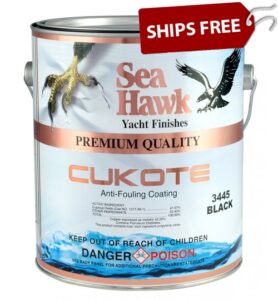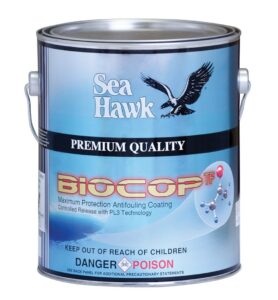Hey boat fans, in this blog post we’re going to discuss antifouling paint, which is much more than a paint; it’s a shield, protecting your boat from the relentless buildup of marine life—barnacles, algae, you name it. But here’s the kicker: when you’re out there, facing the unforgiving elements—blazing UV rays, the corrosive power of saltwater, and relentless biofouling—that paint is going to wear down quicker than you’d like.
So, what do you do? How do you make sure you’re getting the most out of your antifouling paint, especially in extreme conditions? Well, we’re going to share a few expert tips to help you extend the lifespan of your paint and keep your vessel protected.
Choose the Right Type of Antifouling Paint
There are several types of antifouling paints available, each designed to meet different marine conditions. For extreme environments, it’s important to choose a paint that offers both durability and high-performance biofouling protection.
- Hard (Modified Epoxy) Paints: These paints create a tough, abrasion-resistant surface, making them ideal for vessels that face aggressive marine environments or require frequent cleanings. However, they release fewer biocides over time.
- Ablative (Self-Polishing) Paints: Ablative antifouling paints wear down gradually, constantly exposing fresh layers of biocides, which can extend protection. These are especially good for boats in high-fouling areas, as they help prevent thick buildups over time.

Sea Hawk Cukote bottom paint is an ablative, self-polishing antifouling paint that uses an enhanced, copolymer, biocide release mechanism.
- Hybrid Antifouling Paints: Combining features from both hard and ablative paints, hybrid options can offer a balance of durability and consistent performance, suitable for extreme marine conditions.

Biocop TF was developed as an alternative to tin-based antifouling paints to protect against the harshest marine environments.
Surface Preparation is Key
Proper surface preparation is critical to the performance and longevity of antifouling paint. Follow these steps to ensure a strong bond between the paint and the hull:
- Clean the Hull: Before applying antifouling paint, make sure the hull is thoroughly cleaned of any old paint, dirt, or residue. Pressure washing or sandblasting can help remove tough contaminants.
- Sand the Surface: Lightly sanding the surface will improve adhesion, helping the new coat of antifouling paint stick better. Always follow the manufacturer’s instructions for grit size.
- Apply a Primer: Using a marine primer specifically designed for antifouling paint will enhance the paint’s bond with the hull, preventing peeling or flaking over time.

Aquagard® 181 Solvent Based Primer is a single component solvent-based primer designed to promote adhesion of bottom paints on fiberglass, wooden and aluminum boat hulls.
Follow Proper Application Techniques
Applying antifouling paint incorrectly can significantly reduce its lifespan, especially in extreme conditions. Here are some best practices to ensure a strong, long-lasting coat:
- Apply the Correct Thickness: Follow the manufacturer’s recommendations for the number of coats and ensure you apply each one evenly. Too thin of a layer may not provide adequate protection, while too thick could lead to cracking.
- Pay Attention to Drying Times: Extreme marine conditions often involve high humidity or strong sunlight, which can affect how the paint dries. Make sure to follow the drying times specified by the manufacturer based on your local climate conditions.
- Focus on High-Wear Areas: Pay extra attention to areas of the boat that experience the most wear and tear, such as the bow, waterline, and rudder. Consider applying additional coats to these areas for extra protection.
4. Regularly Clean and Inspect the Hull
Even with antifouling paint, your boat will still accumulate some growth in extreme marine environments. Regularly cleaning the hull can help prevent excessive biofouling, which can shorten the paint’s lifespan.
- Use Soft Brushes: Hard scrubbing can wear down antifouling paint, especially ablative types, so opt for a soft brush to remove buildup without stripping away the protective layers.
- Schedule Regular Inspections: Periodically haul out your boat to inspect the hull. Check for any signs of wear, peeling, or excessive fouling. Catching and addressing issues early will help extend the overall life of your antifouling paint.
5. Apply a Fresh Coat at the Right Time
When exposed to harsh marine environments, even the best antifouling paint will eventually wear down. To maximize your protection, be proactive in reapplying paint before it becomes too thin to be effective. Timing varies based on the type of paint used and the conditions, but generally, applying a fresh coat every 12-24 months is recommended for vessels in extreme environments.
6. Consider Environmental Factors
Extreme marine conditions involve more than just water—it also includes UV radiation, salinity, and temperature fluctuations. These factors can degrade antifouling paint faster, so consider these points:
- Use UV-Resistant Paints: Some antifouling paints are formulated with UV blockers to resist the breakdown of the paint’s protective chemicals under harsh sunlight.
- Monitor Water Salinity: Higher salt content in the water can accelerate corrosion, so use a paint designed to withstand these conditions.
Here’s the takeaway: if you want to protect your boat in tough marine conditions, it all comes down to choosing the right antifouling paint and committing to proper application and maintenance. It’s not rocket science, but it does take care. Pick the right paint, prep the hull properly, apply it evenly, and keep up with regular maintenance—that’s how you extend the life of your paint and keep your boat running smoothly.
Need more information or the right products? Head over to Bottom Paint Store. We’ve got everything you need including free technical support so you can keep your boat protected, no matter what the seas throw your way. Stay informed, stay prepared!

